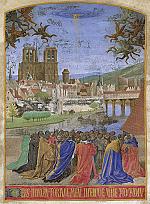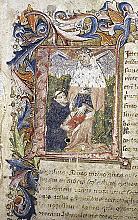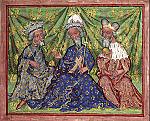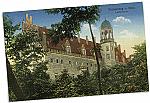Restoring the divine likeness
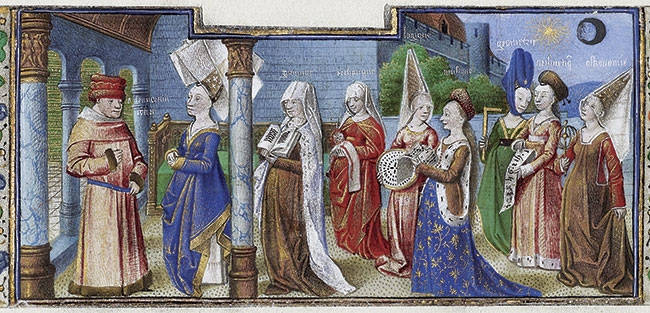
[ABOVE—Coëtivy Master, Philosophy Presenting the Seven Liberal Arts to Boethius Tempera colors, gold leaf, and gold paint on parchment, 1460 to 1460—Getty Center / [Public domain] Wikimedia]
Imagine a time when higher education was intended for character formation rather than as a catapult into a higher income bracket. Imagine a time when university students pursued truth rather than—as many argue now—political correctness and identity politics. The medieval period from which our ideal of a university education emerged was such a time.
We often associate medieval learning with scholasticism, and scholasticism with narrow-minded theological fundamentalists obsessed with abstract, obscure questions. Yet this assumption is foundationally wrong. Medieval universities were dedicated to forming students in both intellectual skills and virtue. They championed a broad education in the liberal arts, promoting the unity of faith and reason for the development of the whole person. For them education was Christ-formation.
These universities invented many structures that persist in modern universities—from lectures in cavernous halls to town-and-gown conflicts to the wearing of academic gowns—but they did not invent this idea of Christ-formation. It grew naturally from the early church and its emphasis on something called Christian humanism. The word “humanism” on a modern popular level calls to mind thinkers who reject God, but for the church fathers, “humanism” was a Christian concern for human flourishing in the light of what Jesus has done for us.
The image of Christ
The apostle Paul fleshed this concept out in his letters to the churches. For Paul Christianity was about “being molded to the image (eikonos) of [God’s] son that he may become the eldest of many brothers and sisters” (Rom. 8:29). Transformation into “the image or likeness (eikona) of the heavenly one” (1 Cor. 15:49) drives the Christian life and fulfills the Christian’s ultimate purpose. And this “heavenly one” in whom “all things were made new” (2 Cor. 5:17) created in himself a “new human being” beyond any racial, national, or even gender divisions.
Paul urged Christians to “put on this new human being” (Eph. 4:24). For Paul God perfected humanity through the Incarnation in Christ and invited his creation to share in this perfection through communion with himself.
Early Christian theologians after the apostles faithfully continued to uphold and unfold Paul’s humanist gospel. They held that in Christ all of creation is reconciled to God and renewed. The church father Irenaeus of Lyon (c. 130–c. 202) famously spoke of humanity’s “recapitulation” in Christ. Through Christ’s Passion and Resurrection, he argued, humanity is collectively taken up and perfected into the intended final form.
The church fathers saw in the Incarnation both the goal of the Christian life and the path to get there. For them the good news and the whole point of Christianity was to become fully human by becoming refashioned into the image of Christ through participation in the humanity of God.
Faith, reason, and culture
This Christian humanist ideal of education already contained two important convictions that would later shape the medieval university. The first was that faith and reason work in harmony to give us a deeper understanding of reality and godly conduct. The goal of Christ-likeness is attainable through knowledge pursued for the sake of wisdom. Thus the path to Christ-likeness is “faith seeking understanding,” the systematic unfolding of belief in God through knowledge. The early church did not regard the pursuit of knowledge as a threat to simple faith, as if logical reasoning waters down genuine belief. Rather it considered knowledge an important tool to build faith (Phil. 1:9, 1 Pet. 3:15).
The second conviction of Christian humanist education that persisted into the medieval university is an expansive view of truth leading to a fearless engagement with philosophy—even pagan philosophy. Christ is the center of reality, the universal Logos (Word) through whom everything had been made (John 1:1) and in whom “all things hang together” (Col. 1:17b). Every true, good, and noble thing, as Paul himself taught, could reflect God’s truth.
Encouraged by Paul’s own use of pagan poets in conversing with Greek philosophers (as in Acts 17:27–28), church fathers freely used Platonic, Aristotelian, and Stoic philosophy for articulating Christian mysteries such as the Trinity, or the union of humanity and divinity in Christ.
In becoming human God revealed himself by means of the material world and social realities. By making himself vulnerable to the mediation of space, time, and culture, God demonstrated that faith, reason, and culture go together.
As Athanasius (c. 296–373) pointed out in On the Incarnation, in Jesus, God became “himself an object for the senses,” with the result that “all things have been filled with the knowledge of God.” For early Christian theologians, “all things” included every valid insight into the human condition.
Therefore Christian thinkers familiar with philosophical currents of their day recognized in them a foreshadowing of God’s revelation in Christ, even while acknowledging decisive differences between those currents and their own faith. Philosophy, after all, means “love of wisdom.” Christ embodies God’s world-sustaining wisdom (1 Cor. 1:24); early theologians like Justin Martyr (c. 100–c. 165) claimed Christianity as “the true philosophy.”
But did the early church naively engage philosophy too much? Would the philosophies of the world leave a stain on the pure faith? In those early Christian centuries, Tertullian (c. 155–c. 225) famously rejected the mixing of pagan thought with Christianity into a syncretistic cocktail: “What has Jerusalem to do with Athens, the Church with the Academy, the Christian with the heretic?” Yet Tertullian’s statement has to be understood as an expression of a shared early church concern to avoid philosophical distortions of the Christian gospel.
“Plunder the Egyptians”
Contrary to a false but tenacious rumor later set afoot by nineteenth-century German scholars such as Adolf von Harnack (1851–1930), early Christian engagement with philosophy did not introduce unbiblical categories. Early apologists for the Christian faith followed Origen’s advice to “plunder the Egyptians” and collect from pagan philosophy every good thing that could serve to promote Christianity. This “plundering,” however, followed two important rules that would profoundly shape medieval education.
First, the plunder had to be genuine treasure; only philosophies or cultural values already compatible with Christianity could serve as preparation for, or explanation of the Christian faith. For this reason Platonic philosophy, which taught assimilation to God, was an early favorite with Christian theologians.
Second, seizing pagan intellectual treasure involved critical appropriation. Origen (c. 184–c. 253) tried to discard from them anything incompatible with the Christian tradition, as did Christian theologians who followed his advice, including the medieval thinker Thomas Aquinas (1225–1274).
Besides using philosophical language to express Christian faith, church fathers also adopted and transformed Greco-Roman educational models. Ancient Greek education of the young for leadership in society focused on rhetoric, grammar, and studying culturally relevant texts, like Homer’s poetry. Poetry and literature were so central to Greek education that the Greek term for education, paideia, came to stand for literature as a whole. Such studies served as preparation for the crowning discipline of philosophy.
Greek paideia aimed to develop a complete, holistic human personality and to form a virtuous, responsible citizen. Following their conquest of Greece, Romans adopted this Greek educational model, turning it into the artes liberales, the liberal arts, dedicated to the cultivation of the mind. Already in Roman antiquity, the liberal arts were shaped like the medieval curriculum into a trivium (grammar, rhetoric, dialectic) and a quad-rivium (arithmetic, geometry, astronomy, and music).
Typically the upper class of free citizens enjoyed the “liberal” or “free” arts, while lower classes received training in the mechanical arts, or what we might today call technical or professional studies. Education was thus divided into two classes: those who worked and those who thought about the purpose of life.
Centered on Scripture
Christians transformed Greek paideia and Roman liberal arts into a liberal arts tradition centered on the Bible. Greek church fathers like Gregory of Nazianzen (329–390) and Basil of Caesaria (330–379), both educated at Athens, recognized in Greek education a common goal of achieving true humanity through developing wisdom and moral virtue. They adapted the model to the Christian goal of becoming more like Christ, a decisive Christian departure point from the Greek model. And Christians insisted on three further major differences.
First, Christian education aimed not at Greek virtues of courage or wisdom, but at transformation to Christ-likeness; second, instead of Homer, the Bible became the central literature for study; and third, theology replaced philosophy as the crowning discipline. Philosophy, secular literature, and all other sciences remained an important part of education, but as handmaids (helpers) to theology. However, even theology itself was subservient to education’s ultimate goal: the process of becoming Christlike.
More than anyone else, Augustine (354–430) imprinted this patristic ideal of Christian humanist education on Western culture. Augustine’s vision is captured in his influential work On Christian Teaching (397, with a fourth book added in 426), which decisively shaped the medieval curriculum. A recent English translation renders the work’s title aptly as Teaching Christianity because the book is a guide for educators of the Christian faith on how to interpret Scripture and communicate its truths.
Augustine’s own classical training in literature and rhetoric, along with his view that the light of God’s truth guides all valid reasoning, prompted him to assert the usefulness of pagan and nonbiblical sources for Christian education. He taught Christians to welcome and appreciate all secular knowledge insofar as it can contribute to becoming more like Christ, or, as Augustine liked to put it, to “becoming fit for the fellowship of angels.”
Following Augustine’s lead the first universities that began to emerge in northern Europe focused on a Christianized version of liberal arts education. Medieval universities arose around the eleventh century, most directly from two institutions: first, from Christian schools of letters and canon law run by cathedrals or monasteries and second, from secular law schools that were independent of the church.
The University of Paris (see pp. 12–15) and later institutions like Cambridge and Oxford in England (see pp. 16–19) were of the first type, while the University of Bologna in Italy (see p. 29) evolved out of the second. Within the universities, liberal arts prepared students for the three graduate subjects of medicine, law, and theology. Theology stood as the queen of the sciences, not because it ruled over the others, but because only God truly grounds and unites all the sciences. Well into the thirteenth century, university education remained focused on assimilating this wisdom of ancient culture, guided by the ideal of ordering all wisdom and knowledge to aid the study of theology.
Truth and virtue
Christian humanism of the early church ran deeply through medieval education, with a concern for education as a restoration of Christ’s image in the learner. According to twelfth-century schoolmaster Hugh of St. Victor (c. 1096–1141), for example, “there are two things which restore the divine likeness in human beings, namely the contemplation of truth and the practice of virtue.” And these two things were the goal of university studies:
This then is what the arts are concerned with, this is what they intend, namely, to restore within us the divine likeness. . . . The more we are conformed to the divine nature, the more do we possess Wisdom, for then there begins to shine forth again in us what has forever existed in the divine Idea or Pattern, coming and going in us but standing changeless in God.
In seeking the recovery of that divine likeness, medieval scholastics walked in the footsteps of their patristic forebears. Education, they believed, contributes to the restoration of the divine image. For this reason they synthesized and compiled authoritative texts from the church fathers, hopeful that this method could repair the fragmentation of knowledge resulting from Adam and Eve’s Fall from communion with God—humankind before the Fall had, they believed, a “perfect system of knowledge,” which the university tried to recover in the service of human flourishing.
The scholastics, like their predecessors in the early church, saw the Incarnation as central to Christian humanism and drew their scholarly energy from the same well: when God’s eternal creating Word and Wisdom, the Son of God, became human in Christ, humanity could be assured of God’s love, the intelligibility of creation, and the trustworthiness of reason.
“Repair job”
On the basis of this conviction, scholastic humanists energetically pursued their “repair job” of restoring the fullness of knowledge to humankind. They remained inspired by the vision of systematic knowledge—now, as was not the case in the early and persecuted church, accompanied by the perfection and extension of an organized Christian society.
This educational ideal often looked different in reality, but on a sheer social and economic level, cathedral schools and the arts programs of the universities served a real need by providing literacy and clerical staff for governing and organizing commercial and legal transactions in Europe.
Ultimately medieval Christian humanism did not succeed. The dream of recovering a complete knowledge of reality became untenable in light of reality’s complexity. When a few hundred books comprised all human knowledge, this dream may have appeared reasonable, but the flood of publications by medieval scholars soon demonstrated the impossibility of this hope.
Moreover its lack of experimental knowledge doomed the scholastic project to failure. The rise of empirical science made obvious that merely summarizing and rehashing ancient assumptions about the cosmos did not advance humanity’s knowledge of nature.
Nevertheless medieval Christian humanists founded the modern university, and their trust in reason laid the foundations for modern science (for more, see CH 134). In addition medieval humanism prepared the ground for the modern concept of the person as unique, irreplaceable, and irreducible to biology or social role. Without this medieval contribution, we would not have current notions of humankind’s dignity, freedom, and rights.
In fact nothing seems more important to many in our day of technological and genetic challenges to human identity than to recover this Christian humanist legacy of the medieval university—where the goal was flourishing in Christ-likeness rather than simply in technical prowess and expertise, and where truth was more important than commercial success or identity politics. CH
By Jens Zimmermann
[Christian History originally published this article in Christian History Issue #139 in 2021]
Jens Zimmermann is J. I. Packer Professor of Theology at Regent College and author of a number of books including Re-Envisioning Christian Humanism: Education and the Restoration of Humanity.Next articles
A guild of learners
What was it like to study at Oxford and Cambridge in the Middle Ages?
G. R. EvansThe backwoods school that changed a continent
How Wittenberg helped spread Protestant reform
Beth KreitzerSupport us
Christian History Institute (CHI) is a non-profit Pennsylvania corporation founded in 1982. Your donations support the continuation of this ministry
Donate



